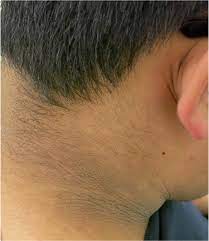Dark Patches, Deeper Truth: When “Neck Grease” Reveals a Hidden Health Warning

We’ve all heard the whispers – hushed comments about “dirty necks” or “greasy elbows.” But what if those seemingly harmless patches held a deeper truth, a silent cry from your body begging to be heard? Introducing Acanthosis nigricans (AN), a skin condition that’s far more than meets the eye.
Lurking in the Shadows:
Imagine velvety, darkened patches taking root in the folds of your skin – your neck, armpits, groin. They might feel slightly raised, almost like rough velvet, and refuse to budge despite your best scrubbing efforts. This, my friends, is AN, a condition often mistaken for simple hygiene issues. But beneath its inconspicuous facade lies a potential health revelation.
The Diabetes Decoder Ring:
While AN can stem from various causes, in many cases, it acts as a secret agent, a hidden clue pointing towards a potential culprit – diabetes. Yes, those seemingly harmless patches could be a sign that your body’s struggling with insulin resistance, a precursor to type 2 diabetes.
Why the Alarm Bells?
Insulin, the sugar-regulating hormone, is like a key unlocking the cells to let glucose, the fuel, enter. In insulin resistance, the key gets a little dull, and the glucose gets locked out, wreaking havoc in the body. AN, in this scenario, is like a neon sign flashing, “Hey, your insulin system might need a tune-up!”
But Wait, There’s More:
AN isn’t a diabetes doomsayer, but a wake-up call. Early detection and management of insulin resistance can prevent or delay the onset of diabetes, keeping you miles ahead of the curve. Think of it as a friendly nudge towards a healthier you.
So, What Now?
If you suspect AN, a trip to your doctor is the next step. They can assess your situation, rule out other causes, and guide you towards the right treatment plan. Remember, AN isn’t a disease, but a symptom – a chance to listen to your body and take charge of your health.
Embrace the Unexpected:
AN might lurk in the shadows, but its message is clear – pay attention to your skin, for it speaks volumes about your inner world. So, the next time you encounter those velvety patches, don’t shy away. Embrace them as a potential health whisper, a chance to unlock a healthier you. And remember, you’re not alone – millions share this silent language, and together, we can rewrite the narrative, one dark patch at a time.
Beyond the Text:
This is just the beginning of the AN story. Let’s delve deeper:
- Unmasking the Myths: Explore common misconceptions surrounding AN and shed light on its true nature.
- The Body’s Canvas: Dive into the science behind AN, understanding how skin reflects internal imbalances.
- Empowering the Whisper: Share inspiring stories of individuals who used AN as a springboard for positive change.
Remember, knowledge is power, and when it comes to your health, even the quietest whispers deserve to be heard. So, let’s rewrite the narrative, one dark patch, one informed voice at a time.
While Acanthosis nigricans (AN) can be associated with diabetes, it’s important to understand that it’s not solely a symptom of this condition. Here are some other potential causes of AN:
Hormonal factors:
- Pregnancy: Hormonal changes during pregnancy can trigger AN, usually resolving after childbirth.
- Polycystic ovary syndrome (PCOS): PCOS disrupts hormone balance, potentially leading to AN.
- Thyroid disorders: Underactive or overactive thyroid function can contribute to AN development.
- Cushing’s syndrome: Excess cortisol production in Cushing’s syndrome can manifest as AN.
Medications:
- Certain medications, such as nicotinic acid, growth hormone, and some birth control pills, can induce AN.
Other medical conditions:
- Cancer: Some cancers, particularly stomach cancer, can cause AN as a side effect.
- Skin infections: Chronic skin infections like acromegaly and pityriasis rubra pilaris can present with AN-like symptoms.
- Obesity: While not a direct cause, obesity can worsen the appearance of existing AN.
Genetic factors:
- In some cases, AN can be inherited, with a family history increasing the risk.
It’s crucial to remember that diagnosing the cause of AN requires a thorough medical evaluation by a qualified healthcare professional. They will consider your medical history, symptoms, and potential risk factors to determine the appropriate course of action.
Here are some additional points to keep in mind:
- Early diagnosis and treatment of the underlying cause is essential for managing AN effectively.
- AN itself is not a dangerous condition, but it can be a sign of a more serious underlying issue.
- If you notice AN patches developing, don’t hesitate to consult your doctor for a proper diagnosis and treatment plan.
Disclaimer: This article is for informational purposes only and should not be interpreted as medical advice. Please consult a healthcare professional for any concerns about your health.




